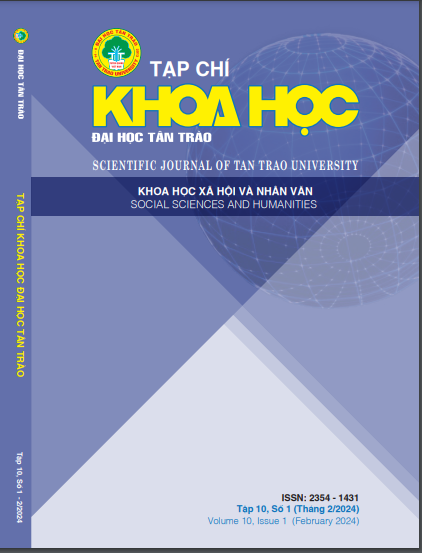USING ONLINE MAPS IN TEACHING GEOGRAPHY TO HIGH SCHOOL STUDENTS IN MOUNTAINOUS REGIONS
DOI:
https://doi.org/10.51453/2354-1431/2024/1133Keywords:
Online map Geography subject High school level Capacity development StudentsAbstract
Strengthening the capacity of students in exploiting and using maps in learning Geography has a particularly important role. Online maps are a modern, popular and effective tool in teaching and learning Geography today. The author of this article uses specialized research methods including: data collection and processing methods, survey & investigation methods, cartographic methods, methods of using information and communication technology, mathematical statistical methods, pedagogical experimental methods to study the exploitation and use of online maps in teaching and learning Geography at high school in the direction of developing students' capacity to contribute to improving effective teaching and learning of Geography. On the basis of theoretical research, the author of the article has developed the principles and teaching process of exploiting and using online maps in Geography at high school level, thereby designing some sample lesson plans. and organize experiments in some high schools. Experimental results show that the subject teaching and the necessary competencies have been improved, including the ability to exploit and use online maps, have been improved among students.
Downloads
References
Allan Brown and M.J. Kraak. (2001). Webcartography: developments and prospects,Taylor & Francis.
Do Vu Son. (2014). Advanced cartography textbook, Thai Nguyen University Publishing House.
Do Vu Son. (2016). Geography Online Teaching Textbook, Thai Nguyen University Publishing House.
Do vu Son, Hoang Minh Chan. (2019). Using Microsoft Encarta software in teaching Geography grade 11-high school with the orientation of developing learners’ capacity. Vietnam Journal of Education, special issue, April 2019, pp.28-34, Hanoi.
Ho Thi Thu Ho, Le Van Nhuong. (2014). Current situation and solutions to using maps in teaching geography 11: Cases in Can Tho city and Hau Giang province. Journal of Science Can Tho University, No. 32, pp.18-24.
https://www.pace.edu.vn/tin-kho-tri-thuc/ky- nang-la-gi#:~:text=K%E1%BB%B9%20 n%C4%83ng%20(skill)%20l%C3%A0%20 n h % E 1 % B B % A F n g , t r o n g % 2 0 c % C 3 % A 1 c % 2 0 t % C 3 % A C n h % 2 0 hu%E1%BB%91ng%20m%E1%BB%9Bi.accessed 12/01/2024.
https://vi.wikipedia.org/wiki/Google_Maps accessed 12/01/2024.
https://earth.google.com/web/@16.46611552,107.58977534,6.94818429a,1625.4133361 4d,35y,0h,0t,0r/data=OgMKATA accessed 12/01/2024.
https://www.google.com/maps/@9.779349,105. 6189045,11z?hl=vi-VN&entry=ttu accessed 12/01/2024.
Michael P. Peterson. (2005). Maps and the internet, Elsevier - ICA.
Ministry of Education and Training. (2018). General Education Program, issued together with Circular No. 32/2018/TT-BGDĐT dated December 26, 2018 of the Minister of Education and Training, Hanoi.
Ministry of Education and Training. (2015). Training materials for integrated teaching in middle and high schools, University of Education Publishers, Hanoi.
Ministry of Education and Training. (2018). General Education Program, issued together with Circular No. 32/2018/TT-BGDĐT dated December 26, 2018 of the Minister of Education and Training, Hanoi.
Nguyen Thanh Xuan. (2018). The role of WebGIS in teaching geography in high schools, Scientific Journal of Hanoi National University of Education, vol 63, Issue 5B, pp. 22-29.Hanoi.
Nguyen Thi Hien .(2021). Applying Bản đồ trực tuyến software in teaching geography at high schools in the direction of developing student capacity. Vietnam Journal of Education, No. 506 (2), pp.29-34, Hanoi.
Nguyen Van Luyen. (2015). Method of using maps in the direction of promoting the activeness of students in teaching Geography, Science
magazine of Ho Chi Minh City University of Education No. 11 (77), pp.59-66. Ho Chi Minh City.
William Cartwright, Michael P. Peterson & Goerg Gartner. (2007). Multimedia Cartography, Springer - Verlag Berlin Heidelberg.
Downloads
Published
How to Cite
Issue
Section
License

This work is licensed under a Creative Commons Attribution-ShareAlike 4.0 International License.
All articles published in SJTTU are licensed under a Creative Commons Attribution-ShareAlike 4.0 International (CC BY-SA) license. This means anyone is free to copy, transform, or redistribute articles for any lawful purpose in any medium, provided they give appropriate attribution to the original author(s) and SJTTU, link to the license, indicate if changes were made, and redistribute any derivative work under the same license.
Copyright on articles is retained by the respective author(s), without restrictions. A non-exclusive license is granted to SJTTU to publish the article and identify itself as its original publisher, along with the commercial right to include the article in a hardcopy issue for sale to libraries and individuals.
Although the conditions of the CC BY-SA license don't apply to authors (as the copyright holder of your article, you have no restrictions on your rights), by submitting to SJTTU, authors recognize the rights of readers, and must grant any third party the right to use their article to the extent provided by the license.


